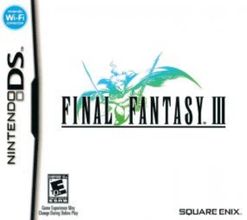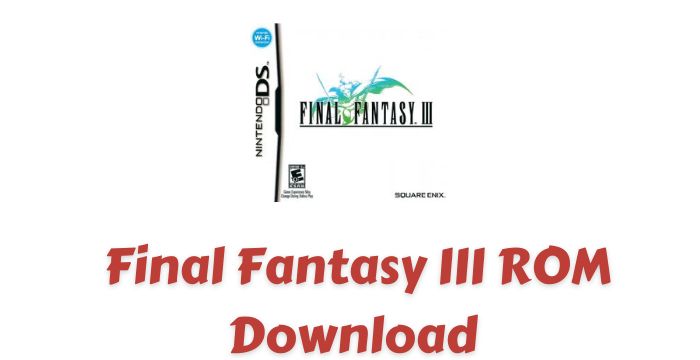An online role-playing game with many players, Final Fantasy 3, is a video game that Square created and launched on the Family Computer. A job-change system was initially introduced in the third Final Fantasy game, which also happens to be the most current entry in the series. The story’s central character is a group of young orphans drawn to a glowing crystal. There are a total of four of them. They are assigned to restore harmony to the planet and get a portion of the crystal’s power in the process. The crystal’s assertions confound them, yet they are conscious of the gravity of their task. They then get in touch with their adoptive parents immediately to get the crystal and bring about global peace.
On April 27, 1990, the video game was made accessible to the general public in Japan for the first time. The first Famicom game is said to have sold over 1.4 million copies in Japan alone. On August 24, 2006, Matrix Software released a recreated version of Final Fantasy III for the Nintendo DS; however, it was not until the next day that the game was made available for purchase outside of Japan. At the time, it was the only Final Fantasy game to be created but never released in Europe or North America. Similar to the first, second, and fourth games in the series, the game was initially intended to be adapted for Bandai’s WonderSwan Color portable. However, owing to several delays, the project was eventually abandoned. Similar to the series’s first, second, and fourth games, the game would have been released. The first two episodes of the series and the fourth episode that followed both used this tactic. The popularity of the Nintendo DS version of the game is shown by the estimated 2 million copies that have reportedly been sold worldwide.

| ROM | Final Fantasy III ROM |
| Category | RPG |
| Developer | SQUARE ENIX |
| Latest Version | v2.0.1 |
| Console: | NDS |
Also download Pokemon Ranger ROM
Table of Contents
Gameplay of Final Fantasy III ROM
Final Fantasy III’s gameplay is a hybrid, combining elements from the first two Final Fantasy games with some all-new innovations. The third game continues the previous two games’ turn-based, tactical fighting concept. The target’s current hit points are now shown above them rather than being explained like they were in the first two games following an attack or healing action, however. Now that a unit has died, the game will automatically target that unit’s location for physical attacks. This is true whether the team was an ally or an adversary. In contrast to other games in the series, magical attacks do not always reach their intended targets.
The experience point system from the first Final Fantasy has been brought back after being removed from Final Fantasy II. The character-class system from the first Final Fantasy is also back, with several noteworthy changes and enhancements. Final Fantasy III introduced the “job system,” which would later become one of the series’ most recognizable elements. The series’ first game to take advantage of this feature was this one. When playing the first game, the player chooses each character’s class alignment at the start and is forced to play that class for the remainder of the game. The Famicom version of the game’s four main characters start as “Onion Knights,” but as the plot develops, they have access to various other vocations. The four main protagonists of the game’s Super Nintendo version start their journeys as “Onion Knights.” Each playable character may choose from among the whole range of available professions, and they are free to do so at any time throughout the game. To change careers, Capacity Points are required. The whole squad receives capacity points similar to Gil and is awarded at the end of each battle. Each class’s armament, available offensive and defensive weapons, and available magical spells vary significantly. The length of time a character spends in a particular career is directly inversely related to the level of expertise the character has in that subject. Characters with higher levels in a career are better in battle and use fewer capacity points to switch between that profession and others. Additionally, there is a decrease in the cost of a job change in capacity points.
Specialized combat commands, including Steal and Jump, make their first appearance in Final Fantasy III. Each order is associated with a particular profession (“Steal” is the specialty of the Thief, while “Jump” is the forte of the Dragoon”). Some jobs may need the possession of abilities unrelated to violence. For instance, a thief can open locks that ordinarily need a unique key. Final Fantasy III was the first game in the series to include summoned monsters and the first to have the “Summon” skill. The “Summon” skill may summon these creatures into existence.
Features of Final Fantasy III ROM
One thousand years before the game’s events, a highly evolved civilization emerged on an unidentified planet on a continent that floated above the planet’s surface. The four elemental crystals of light that made up the continent were the source of the power that this culture sought to harness. They were unaware that even the most fundamental elements of their natural environment were not at all susceptible to their control. If not for the four dark elemental crystals, which function as their natural analogs in the natural world, the power of the light crystals would have been sufficient to destroy the planet.
Four brave warriors were granted the capacity to harness the dark crystals’ strength to reclaim the light crystals’ power after an unforeseen disturbance to the balance between light and dark. Peace and serenity have been restored worldwide thanks to the so-called Dark Warriors’ accomplishment of their goal. Although their rafting continent was saved, it was too late for their victory to save the vanishing civilization, and its culture was destroyed. A race of prophets and seers who were blind called the Gulgans formerly lived on that continent. They predicted that similar events would recur in the future.
Final Fantasy III’s plot revolves around the adventures of four orphans from the sleepy town of Ur. Unlike the original game and other early Final Fantasy games, players of the remakes start the game as Luneth, and they unlock the other three characters as the game progresses. Regardless of their game, all four orphans start as Onion Knights.
Whenever the balance between light and darkness is upset, the Cloud of Darkness can devour the planet and throw it into chaos and darkness. For most of the game, the malevolent Xande acts as the primary enemy, but it is ultimately found that Xande is nothing more than a puppet controlled by the Cloud of Darkness. The Cloud of Darkness, which assumes the form of a female human, talks of herself in the first person plural since each of her two tentacles has its awareness. She initially beat the Light Warriors, but she finally lost when Unei and Doga were able to bring them back to life. They were then able to defeat the Cloud of Darkness and save Earth with the aid of the Dark Warriors.
Nobuo Uematsu, who has contributed to the soundtracks of other games in the series, wrote the music for Final Fantasy III. Final Fantasy III Original Sound Version, the album’s initial release, was made available in 1991 by Square/NTT Publishing. Two more printings of the book were done by NTT Publishing, one in 1994 and the other in 2004. Nearly all of the songs included in the game are retained on the CD. Nobuo Uematsu also produced the album. The supplemental CD features a range of Nobuo Uematsu’s interpretations of musical pieces from the game. The Data M label first issued the album in 1990; then, in 1994, it was distributed by the Polystar label.
The second and third albums by Uematsu’s progressive metal band, The Black Mages, as well as a number of the Final Fantasy, arranged music compilation albums, including Final Fantasy: Pray and Final Fantasy: Love Will Grow (with lyrical renditions performed by singer Risa Ohki), all include arrangements of specific game tracks. Final Fantasy: Pray, and Final Fantasy: Love Will Grow is two additional compilation albums of music from the Final Fantasy video game. Singer Risa Oh contributed lyrical versions to both albums. A couple of the game’s songs were later used in other Square or Square Enix games, such as Chocobo Racing and Final Fantasy Fables: Chocobo’s Tale. The Final Fantasy soundtrack has been included in several symphonic concert series all around the globe due to its ongoing popularity, including the Tour de Japon: Music from Final Fantasy and the Distant Worlds: Music from Final Fantasy. Songs from the original soundtrack have been used in both of these series in various arrangements.
FAQS of Final Fantasy III ROM
Should you play the original Final Fantasy III or the HD remake?
The DS version is unquestionably superior to the others. The PSP edition looks horrible and is deficient in new features and extra material compared to the DS version. This is untrue since the PSP version wasn’t released until much later because of delays. The only differences between the DS and other arrangements are the absence of the turbo and auto-battle options.
How hard is Final Fantasy 3 to play?
The slope of the difficulty curve is steep. Final Fantasy III’s last dungeons and monster fights are renowned for their difficulty. Anyone who has played Final Fantasy IV will immediately see the similarities between the two games. There was no method to save your progress, so it took a lot of work.
Is Final Fantasy III’s anticipated release date known?
You can finish Final Fantasy III in around 1812 hours if you play it often. You should budget about 23.5 hours to spend on the game if you’re the kind to want to see and do everything.
Conclusion
A manga based on the game’s original story, which Kenji Terada authored, detailed the game’s events. Following that, the short stories were collected and published in three tankobon, or bound volumes, under the Dragon Comics imprint, owned by Kadokawa Shoten. The three tankobon are titled Legend of the Eternal Wind 1, 2, and 3.
Dissidia Final Fantasy has playable versions of the Onion Knight and the Cloud of Darkness, both from Final Fantasy III. The protagonist and antagonist of the game in the Japanese version are voiced by Jun Fukuyama and Masako Ikeda, respectively. Aaron Spann and Laura Bailey display these characters in the game’s English translation. The original cast members from the first game returned in the successors to that one, titled Dissidia Final Fantasy NT and Dissidia 012 Final Fantasy, respectively.

